Key to Polyrhachis (Hagiomyrma) species
The following key to Polyrhachis (Hagiomyrma) species (based on the worker caste) is modified from Kohout (2013[1]) as updated by Hoffmann (2015[2]).
You may also be interested in
1
- Generally larger species (HL > 2.20) . . . . . 2
- Generally medium-sized or small species (HL < 2.15) . . . . . 14
2
return to couplet #1
- Pronotal dorsum with margins strongly converging anteriorly; occipital corners with distinct postocular carinae; anterior clypeal margin deeply emarginate medially (New Guinea and Bismarck Archipelago) . . . . . Polyrhachis metella
 Head of Polyrhachis metella worker |
 Profile of Polyrhachis metella worker |
- Pronotal dorsum more-or-less quadrate or only weakly converging anteriorly; occipital corners simply rounded, without postocular carinae; anterior clypeal margin medially with denticulate flange or simply truncate . . . . . 3
3
return to couplet #2
- Gaster with pubescence very much diluted, virtually lacking; head and mesosoma with long, rich golden pubescence (QLD, NSW, VIC) . . . . . Polyrhachis semiaurata
 Head of Polyrhachis semiaurata worker |
 Profile of Polyrhachis semiaurata worker |
- Gaster with golden or silvery pubescence identical or similar to that on dorsum of head and mesosoma . . . . . 4
4
return to couplet #3
- Pronotal humeri distinctly angular; dorsum of first gastral tergite strongly tranverse, laterally produced into narrowly rounded prominences (Cape York Pen., Mt Tozer, QLD) . . . . . Polyrhachis vernoni
 Polyrhachis vernoni worker |
 Polyrhachis vernoni worker |
- Pronotal humeri narrowly or widely rounded; dorsum of first gastral tergite less transverse, with sides widely rounded . . . . . 5
5
return to couplet #4
- Petiolar node relatively thick in profile with dorsum widely rounded or forming more-or-less flat platform; petiolar spines short, bases situated well below summit of dorsal convexity . . . . . 6
- Petiolar node in profile with anterior and posterior face converging towards narrowly rounded dorsum; petiolar spines longer, bases situated at lateral corners of dorsal summit . . . . . 7
6
return to couplet #5
- Pronotal dorsum with margins weakly converging anteriorly; propodeal spines subparallel; head in full face view with numerous hairs fringing lateral outline between eyes and mandibular bases (Cape York Pen., McIlwraith Range, QLD) . . . . . Polyrhachis darlingtoni
 Polyrhachis darlingtoni worker |
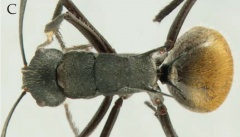 Polyrhachis darlingtoni worker |
- Pronotal dorsum more-or-less quadrate; propodeal spines divergent head in full face view with no hairs fringing lateral outline between eyes and mandibular bases (Mt Abbott, QLD) . . . . . Polyrhachis burwelli
 Polyrhachis burwelli worker |
 Polyrhachis burwelli worker |
7
return to couplet #5
- Dorsum of gaster with golden or silvery pubescence and more-or-less distinct, dark reddish-brown, median patch, extending from dorsum of first gastral tergite towards apex . . . . . 8
- Dorsum of gaster with widely diffused patch of golden pubescence extending towards apex; reddish-brown median patch on gaster not evident . . . . . 12
8
return to couplet #7
- Median patch on gastral dorsum very dark and prominent . . . . . 9
- Median patch on gastral dorsum lighter and less prominent . . . . . 10
9
return to couplet #8
- Dorsum of pronotum with only a few, relatively short, erect hairs; hairs completely absent from mesonotum, propodeum, including declivity, and propodeal spines (central QLD) . . . . . Polyrhachis conciliata
 Head of Polyrhachis conciliata worker |
 Profile of Polyrhachis conciliata worker |
- Dorsum of mesosoma, including bases of propodeal spines, with numerous erect or semierect, long or medium length hairs (central QLD) . . . . . Polyrhachis callima
 Head of Polyrhachis callima worker |
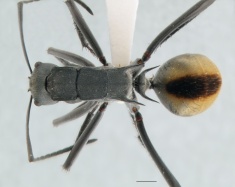 Profile of Polyrhachis callima worker |
10
return to couplet #8
- Pronotal dorsum with margins weakly converging anteriorly (Cooktown district, QLD) . . . . . Polyrhachis feehani
 Polyrhachis feehani worker |
 Polyrhachis feehani worker |
- Pronotal dorsum more-or-less quadrate or weakly converging posteriorly . . . . . 11
11
return to couplet #10
- Smaller species (HL 2.18-2.37); clypeus virtually straight in profile; dorsa of head and mesosoma with rich golden pubescence, radiating towards midline of mesosoma (Brisbane district, QLD) . . . . . Polyrhachis brisbanensis
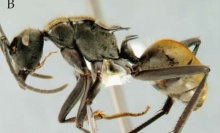 Polyrhachis brisbanensis worker |
 Polyrhachis brisbanensis worker |
- Larger species (HL 2.28-2.62); clypeus sinuate in profile; dorsa of head and mesosoma with pubescence mostly silvery, diffused into pale golden along midline of mesosoma (central QLD) . . . . . Polyrhachis brutella
 Polyrhachis brutella worker |
 Polyrhachis brutella worker |
12
return to couplet #7
- Petiolar spines subparallel, shorter than distance between their bases; dorsa of head and mesosoma with evenly distributed golden pubescence . . . . . 13
- Petiolar spines divergent, about as long as or longer than distance between their bases; body pubescence unevenly distributed with head distinctly less pubescent than dorsum of mesosoma (QLD, NSW, VIC) . . . . . Polyrhachis ammon (in part - also #44)
 Polyrhachis ammon worker |
 Polyrhachis ammon worker |
13
return to couplet #12
- Smaller species (HL 2.02-2.24); propodeal spines widely divergent; petiolar spines strongly downturned (QLD) . . . . . Polyrhachis uncaria (in part - also #44)
 Polyrhachis uncaria worker |
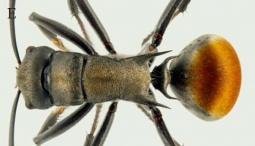 Polyrhachis uncaria worker |
- Larger species (HL 2.21-2.40); propodeal spines subparallel; petiolar spines more-or-less horizontal (Hann Tbld, QLD) . . . . . Polyrhachis dougcooki
 Polyrhachis dougcooki worker |
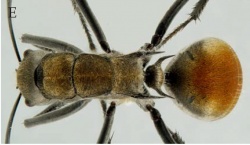 Polyrhachis dougcooki worker |
14
return to couplet #1
- Dorsum of mesosoma distinctly short and wide; propodeal spiracles situated on prominent, laterally projecting tubercles; petiolar dorsum strongly transverse, armed with very short spines . . . . . 15
- Dorsum of mesosoma more-or-less elongated; propodeal spiracles relatively flat, not situated on prominent tubercles; petiolar dorsum armed with spines of various lengths . . . . . 16
15
return to couplet #14
- Head and mesosoma with distinct, closely appressed, golden pubescence; dorsum of gaster with only a few, medium length hairs and no pubescence (Cape York Pen., QLD) . . . . . Polyrhachis diversa
 Polyrhachis diversa worker |
 Polyrhachis diversa worker |
- Head and mesosoma without appressed pubescence; dorsum of gaster with very fine, closely appressed, pale golden pubescence (QLD) . . . . . Polyrhachis tubifera
 Head of Polyrhachis tubifera worker |
 Profile of Polyrhachis tubifera worker |
16
return to couplet #14
- Head and mesosoma generally black, with only mouthparts, pronotal collar, spines and appendages occasionally reddish-brown . . . . . 24
- Head and mesosoma not black, coloured or multi-coloured . . . . . 17
17
return to couplet #16
- Lateral margins of promesonotum strongly converging posteriorly (PMI > 190) . . . . . 18
- Lateral margins of promesonotum less strongly converging posteriorly (PMI < 180) or subparallel . . . . . 20
18
return to couplet #17
- Generally smaller species (HL 1.31-1.56); antennal scapes virtually circular in cross-section; dorsum of gaster with distinct, thick silvery or golden, appressed pubescence (New Guinea, WA, NT, QLD) . . . . . Polyrhachis schenckii
 Head of Polyrhachis schenckii worker |
 Profile of Polyrhachis schenckii worker |
- Generally larger species (HL 1.53-1.75); antennal scapes somewhat flattened, oval in cross-section; appressed pubescence on dorsum of gaster very sparse or lacking . . . . . 19
19
return to couplet #18
- Antennal scapes relatively short (SI 123); greatest width of pronotal dorsum near its mid-length; propodeal spines obliquely elevated from bases (NT) . . . . . Polyrhachis isolata
 Polyrhachis isolata worker |
 Polyrhachis isolata worker |
- Antennal scapes relatively long (SI 134-143); greatest width of pronotal dorsum across humeri; propodeal spines horizontal (Cape York Pen., QLD) . . . . . Polyrhachis injinooi
 Polyrhachis injinooi worker |
 Polyrhachis injinooi worker |
20
return to couplet #17
- Head, mesosoma and gaster metallic green, with front of head, anterior portion of pronotum and appendages orange or reddish-brown (QLD) . . . . . Polyrhachis lydiae
 Head of Polyrhachis lydiae worker |
 Profile of Polyrhachis lydiae worker |
- Head, mesosoma and gaster not metallic green, mostly medium to dark reddish-brown or red with gaster distinctly darker . . . . . 21
21
return to couplet #20
- Head and mesosoma conspicuously red or orange-red; gaster very dark brown; appendages reddish-brown (WA, NT, QLD) . . . . . Polyrhachis bohemia
 Head of Polyrhachis bohemia worker |
 Profile of Polyrhachis bohemia worker |
- Head and mesosoma almost uniformly medium to dark reddish- brown with gaster usually a shade lighter; appendages reddish-brown . . . . . 22
22
return to couplet #21
- Pronotal humeri produced into dilated, dorsally shallowly concave, rounded prominences; head and mesosoma with more-or-less distinct, vermiculate sculpturation . . . . . 23
- Pronotal humeri narrowly rounded; body sculpturation reticulate- punctate, not vermiculate (Cape York Pen., QLD) . . . . . Polyrhachis capeyorkensis
 Polyrhachis capeyorkensis worker |
 Polyrhachis capeyorkensis worker |
23
return to couplet #22
- Head and mesosoma reticulate-punctate, shallowly vermiculate- rugose on vertex of head and dorsum of mesosoma; colour almost uniformly medium reddish-brown, appendages and spines a shade lighter (QLD) . . . . . Polyrhachis lachesis
 Head of Polyrhachis lachesis worker |
 Profile of Polyrhachis lachesis worker |
- Head and mesosoma with very distinct, vermiculate-rugose sculpturation; colour mostly black or very dark reddish-brown on most dorsal surfaces; appendages and spines distinctly lighter (Indonesia, New Guinea, Cape York, QLD) . . . . . Polyrhachis paxilla (in part - also #31)
 Head of Polyrhachis paxilla worker |
 Profile of Polyrhachis paxilla worker |
24
return to couplet #16
- Antennal scapes with at least a few short, bristle-like hairs along leading edge . . . . . 25
- Antennal scapes without any hairs along leading edge . . . . . 35
25
return to couplet #24
- Promesonotal lateral margins only very weakly converging posteriorly (PMI < 140); petiole in lateral view rather low with very short, curved spines (NT) . . . . . Polyrhachis nourlangie
 Polyrhachis nourlangie worker |
 Polyrhachis nourlangie worker |
- Promesonotal lateral margins more strongly converging posteriorly (PMI > 150); petiole in lateral view distinctly higher with longer spines of various configurations . . . . . 26
26
return to couplet #25
- Outline of head in full face view with numerous, bristle-like hairs fringing margin between eyes and mandibular bases . . . . . 27
- Outline of head in full face view without hairs, or at most with only a few, inconspicuous, very short hairs fringing margin between eyes and mandibular bases . . . . . 27a
27
return to couplet #26
- Head, mesosoma and petiole very distinctly and evenly, rather coarsely, reticulate-punctate; petiole in profile with posterior face distinctly convex and swollen towards base (Nth QLD) . . . . . Polyrhachis tenebra
 Polyrhachis tenebra worker |
 Polyrhachis tenebra worker |
- Head, mesosoma and petiole finely reticulate-punctate with sculpture somewhat longitudinally rugulate-striate on vertex of head; petiole in profile with posterior face only weakly convex (New Ireland, New Guinea, Cape York Pen.) . . . . . Polyrhachis semiobscura
 Head of Polyrhachis semiobscura worker |
 Profile of Polyrhachis semiobscura worker |
27a
- Petiole armed with rather massive, bull horn-shaped spines (NT only) => Polyrhachis kohouti
 Head of Polyrhachis kohouti worker |
 Profile of Polyrhachis kohouti worker |
- Petiole armed with slender, acute spines, mostly curved into shape of first gastral segment or downcurved => 28
28
return to couplet #26
- Petiolar spines distinctly downcurved, hook-like (only WA) . . . . . Polyrhachis ammonoeides
 Head of Polyrhachis ammonoeides worker |
 Profile of Polyrhachis ammonoeides worker |
- Petiolar spines more-or-less horizontal or obliquely elevated, never hook-like . . . . . 29
29
return to couplet #28
- Promesonotal lateral margins distinctly converging posteriorly (PMI > 190) . . . . . . 30
- Promesonotal lateral margins less strongly converging posteriorly (PMI < 180) . . . . . 31
30
return to couplet #29
- Antennal scapes relatively short (SI < 141); petiole in profile with posterior face only weakly convex towards base (Nth QLD) . . . . . Polyrhachis stricta
 Polyrhachis stricta worker |
 Polyrhachis stricta worker |
- Antennal scapes relatively long (SI > 154); petiole in profile distinctly swollen towards base (NT) . . . . . Polyrhachis weiri
 Polyrhachis weiri worker |
 Polyrhachis weiri worker |
31
return to couplet #29
- Pronotal dorsum with humeri produced into dilated, distinctly rounded prominences; head and mesosoma with distinct, vermiculate sculpturation (Indonesia, New Guinea, Cape York) . . . . . Polyrhachis paxilla (in part - also #23)
 Head of Polyrhachis paxilla worker |
 Profile of Polyrhachis paxilla worker |
- Pronotal dorsum with humeri rounded or subangular, not distinctly dilated; head and mesosoma reticulate-punctate . . . . . 32
32
return to couplet #31
- Petiolar node in profile with posterior face distinctly swollen towards base; clypeus in profile virtually straight or only very shallowly impressed anteriorly . . . . . 33
- Petiolar node in profile with posterior face not distinctly swollen, descending towards base in weakly convex line; clypeus in profile distinctly sinuate (Nth QLD) . . . . . Polyrhachis placida
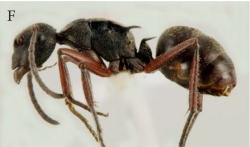 Polyrhachis placida worker |
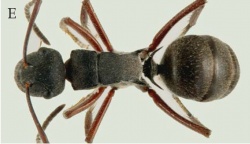 Polyrhachis placida worker |
33
return to couplet #32
- Dorsum of gaster with distinct, closely appressed, golden pubescence, completely hiding underlying sculpturation (Pilbara, WA) . . . . . Polyrhachis pilbara
 Polyrhachis pilbara worker |
 Polyrhachis pilbara worker |
- Dorsum of gaster with much diluted, silvery or golden, appressed pubescence . . . . . 34
34
return to couplet #33
- Dorsum of mesosoma with very short, erect, bristle-like hairs (Barrow I., WA) . . . . . Polyrhachis seducta
 Head of Polyrhachis seducta worker |
 Profile of Polyrhachis seducta worker |
- Dorsum of mesosoma with distinctly longer, posteriorly directed hairs that are up to half greatest diameter of eyes in length (Tanami Desert, NT) . . . . . Polyrhachis tanami
 Polyrhachis tanami worker |
 Polyrhachis tanami worker |
35
return to couplet #24
- Promesonotal lateral margins strongly converging posteriorly (PMI > 185) . . . . . 36
- Promesonotal lateral margins less strongly or weakly converging posteriorly (PMI < 180) . . . . . 37
36
return to couplet #35
- Dorsum of petiole with flat, strongly posteriorly sloping, triangular platform; petiolar spines obliquely elevated; propodeal spines subparallel or only weakly divergent; antennal scapes relatively short (SI < 142) (NT, QLD) . . . . . Polyrhachis trapezoidea
 Head of Polyrhachis trapezoidea worker |
 Profile of Polyrhachis trapezoidea worker |
- Dorsum of petiole narrowly rounded, without flat platform; petiolar spines horizontal; propodeal spines widely divergent; antennal scapes longer (SI > 160) (Paluma, Mt Elliot) . . . . . Polyrhachis aurora
 Head of Polyrhachis aurora worker |
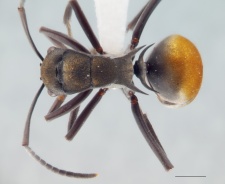 Profile of Polyrhachis aurora worker |
37
return to couplet #35
- Propodeal spines strongly divergent and long, distinctly longer than distance between their bases . . . . . 38
- Propodeal spines less strongly divergent or subparallel, distinctly shorter than distance between their bases . . . . . 39
38
return to couplet #37
- Dorsum of body without hairs, except a few, short hairs on apical gastral tergites; closely appressed pubescence very diluted with whole body superficially glabrous (NT, Nth QLD) . . . . . Polyrhachis cracenta
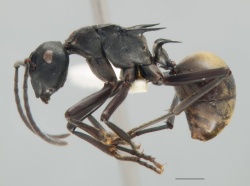 Polyrhachis cracenta worker |
 Polyrhachis cracenta worker |
- Dorsum of mesosoma with rather sporadic hairs of various lengths; gaster with hairs more abundant, notably on venter; appressed, golden pubescence diluted on most body surfaces, except rather dense on gastral dorsum (WA, NT, Nth QLD) . . . . . Polyrhachis crawleyi
 Head of Polyrhachis crawleyi worker |
 Profile of Polyrhachis crawleyi worker |
39
return to couplet #37
- Dorsum of petiole with flat, transversely wide platform; dorsum of body with very abundant, long silvery hairs that are distinctly longer than greatest diameter of eyes; antennal scapes very short (SI < 125) (Cape York Pen., Nth QLD) . . . . . Polyrhachis thusnelda
 Head of Polyrhachis thusnelda worker |
 Profile of Polyrhachis thusnelda worker |
- Dorsum of petiole narrowly rounded without flat platform; body with relatively short, erect hairs or, at most, with only sporadic, variously curved, longer hairs (as in P. hoffmanni and P. denticulata); antennal scapes longer (SI > 125) . . . . . 40
40
return to couplet #39
- Dorsum of head and mesosoma with distinct, rather abundant, mostly golden, medially radiating pubescence . . . . . 41
- Dorsum of head and mesosoma with rather diluted, mostly silvery, variously scattered pubescence . . . . . 45
41
return to couplet #40
- Petiolar node in side view with anterior and posterior faces subparallel towards base; antennal scapes rather short (SI < 137) (Nth QLD) . . . . . Polyrhachis electra
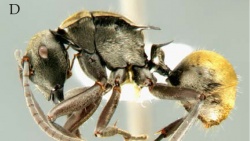 Polyrhachis electra worker |
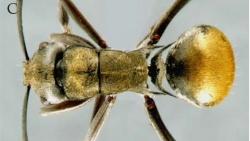 Polyrhachis electra worker |
- Petiolar node in side view with anterior and posterior faces converging dorsally; posterior face descending towards base in oblique, almost straight line . . . . . 42
42
return to couplet #41
- Dorsum of mesosoma distinctly slender (PMI > 167); propodeal spines obliquely elevated from bases; petiolar spines widely divergent, very slender and long, about as long as distance between their bases (QLD, NSW) . . . . . Polyrhachis angusta
 Polyrhachis angusta worker |
 Polyrhachis angusta worker |
- Dorsum of mesosoma not distinctly slender (PMI < 167); propodeal spines more-or-less horizontal or weakly downturned; petiolar spines subparallel or only weakly divergent, distinctly shorter than distance between their bases . . . . . 43
43
return to couplet #42
- Petiolar spines divergent, obliquely elevated from bases; propodeal spines virtually parallel along entire length (Nth QLD) . . . . . Polyrhachis elegantula
 Polyrhachis elegantula worker |
 Polyrhachis elegantula worker |
- Petiolar spines only weakly divergent or subparallel, horizontal or downturned; propodeal spines weakly divergent with tips curved outwards . . . . . 44
44
return to couplet #43
- Petiolar spines horizontal; dorsum of gaster with wide median patch of golden pubescence, laterally diffused into pale golden and silvery on sides and venter . . . . . Polyrhachis ammon (in part - also #12)
 Polyrhachis ammon worker |
 Polyrhachis ammon worker |
- Petiolar spines strongly downturned from bases; whole dorsum of gaster with distinct, reddish-golden pubescence, lined with silvery pubescence on sides and venter . . . . . Polyrhachis uncaria (in part - also #13)
 Polyrhachis uncaria worker |
 Polyrhachis uncaria worker |
45
return to couplet #40
- Dorsum of mesosoma with rather long, variously curved, scattered hairs; hairs more abundant and posteriorly directed on gaster . . . . . 46
- Dorsum of mesosoma virtually lacking hairs or with only very short, much diluted hairs on dorsal body surfaces, including gaster . . . . . 47
46
return to couplet #45
- Promesonotal lateral margins strongly converging posteriorly (PMI > 170); body with variously curved, scattered hairs that are longer than half of greatest diameter of eyes; posterior face of petiolar node convex, but not distinctly swollen (Indonesia, New Guinea, Bismarck Archipelago, Torres Strait) . . . . . Polyrhachis denticulata
 Head of Polyrhachis denticulata worker |
 Profile of Polyrhachis denticulata worker |
- Promesonotal lateral margins rather weakly converging posteriorly (PMI < 145); body with variously curved hairs, most longer than greatest diameter of eyes; posterior face of petiolar node distinctly swollen towards base (Nth western QLD) . . . . . Polyrhachis hoffmanni
 Polyrhachis hoffmanni worker |
 Polyrhachis hoffmanni worker |
47
return to couplet #45
- Dorsum of petiole tranversely narrow, rather deeply concave between closely approximated bases of spines . . . . . 48
- Dorsum of petiole flat or very weakly concave; bases of spines separated by transversely wide dorsum of segment . . . . . 50
48
return to couplet #47
- Petiolar spines widely divergent, highly obliquely elevated; propodeal spines very slender, divergent; posterior face of petiolar node convex but not distinctly swollen (Geraldton, WA) . . . . . Polyrhachis clarki
 Polyrhachis clarki worker |
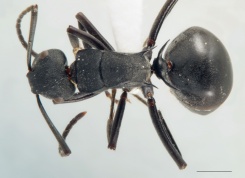 Polyrhachis clarki worker |
- Petiolar spines parallel or only weakly divergent, moderately elevated; propodeal spines subparallel; posterior face of petiolar node distinctly swollen towards base . . . . . 49
49
return to couplet #48
- Smaller species (HL < 1.62); anterior clypeal margin truncate medially; bases of petiolar spines very closely approximated, spines subparallel; body sculpture very finely reticulate-punctate, semi- polished (WA, NT) . . . . . Polyrhachis anderseni
 Polyrhachis anderseni worker |
 Polyrhachis anderseni worker |
- Larger species (HL > 1.62); anterior clypeal margin with denticulate median flange; bases of petiolar spines more widely separated, spines weakly; body sculpture closely reticulate-punctate, distinctly opaque (NT, Gulf Country, QLD) . . . . . Polyrhachis archeri
 Polyrhachis archeri worker |
 Polyrhachis archeri worker |
50
return to couplet #47
- Petiole with posterior face distinctly swollen towards base; petiolar spines elevated from bases; head and mesosoma with rather sporadic, very short, bristle-like hairs, no hairs on dorsum of petiole; body sculpture closely reticulate- punctate, distinctly opaque (WA, NT, QLD) . . . . . Polyrhachis melanura
 Head of Polyrhachis melanura worker |
 Profile of Polyrhachis melanura worker |
- Petiole with posterior face only moderately convex towards base; petiolar spines horizontal; head, mesosoma and petiole with more abundant, marginally longer hairs; body sculpture finely reticulate-punctate, semi-polished (Nth and Central QLD) . . . . . Polyrhachis penelope
 Head of Polyrhachis penelope worker |
 Profile of Polyrhachis penelope worker |
- ↑ Kohout, R.J. 2013. Revision of Polyrhachis (Hagiomyrma) Wheeler, 1911 (Insecta: Hymenoptera: Formicidae: Formicinae). Memoirs of the Queensland Museum, Nature 56, 487-577.
- ↑ Hoffmann, B.D. 2015. A new species of Polyrhachis (Hagiomyrma) from the Northern Territory, Australia (Hymenoptera: Formicidae: Formicinae). Australian Entomologist 42: 53-58.